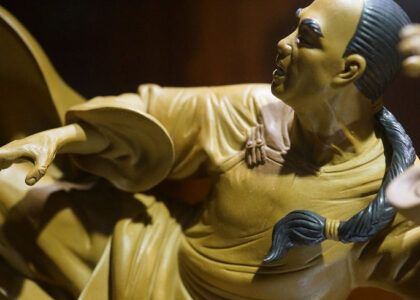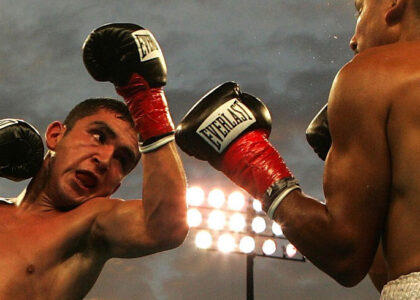The tale of Richard Peeke, an English sailor captured during a raid on Spanish coastal towns in 1625, was popular during his own time, but showed renewed interest during the Victorian era for Peeke’s display of manly virtue. Today, the tale is often told honoring the efficacy of the traditional quarterstaff, which, common weapon though it may have been, was adroitly used by Peeke against three Spanish swordsmen wielding rapiers and daggers.

Camillo Aggrippa: Trattato di Scientia d’Arme (1553)
A rapier, and especially a rapier and dagger, could quickly ruin anyone’s day. A three to four foot length of steel with a sharp point and two cutting edges, not to mention the supporting dagger for parrying and stabbing, could leave a combatant leaking blood quicker than one can say “en garde.”
However, the humble quarterstaff was deadly in its own right, and a favorite of the contemporaneous English Masters of Defence, such as George Silver and Joseph Swetnam. Both, in fact, would likely have been pleased but not surprised at Peeke’s exploits.
Silver, calling it the short staffe, said a single staff wielder “has advantage against two sword and daggers, or two rapiers, poniards and gauntlets [because] the distance appertaining to the staff man, either to keep or break, stands upon the moving of one large space always at the most, both for his offense or safety [whereas] the other two…have always four paces at the least; therein they fall too great in number with their feet, and too short in distance to offend the staff man.”
Silver goes on to elucidate how, because of the superior reach of the staff, the two swordsmen must circle at the rate of twenty feet for every foot of pivot the staff man takes, and gives the principles for effective use against two swordsman.

The Schoole of the Noble and Worthy Science of Defence
Joseph Swetnam (1617)
Swetnam liked the staff over other pole weapons because it was not as top-heavy, and therefore it could be used to feint against a hook or halberd, whose response “will so over-carrie him by reason of the weight, that hee cannot command him nimbly backe againe.”
Ultimately, Swetnam counts skill more important than choice of weapon: “yet I must needes confesse, there is great oddes in the Staffe, if the Staffe-man bee verie skillful, but otherwise the Rapier and Dagger hath the oddes being furnished with skill.”
Note the hand positioning in the Swetnam woodcut: butt and quarter up, rather than the equal thirds portrayed in Robin Hood movies; the thirds positioning is half-staffing and came into vogue primarily as a safe bouting method and as stage technique. Swetnam mentions the half-staffe in passing, but finds that the hands “are in danger of every blow that cometh.”
Richard Peeke’s Tale
Peeke’s tale is fascinating as a vignette of the larger events surrounding his own experience. For a century surrounding Peeke’s exploits, Spain and England were rivals, friends, or enemies depending upon the economic and political climate of any one time; part of this period is referred to as the undeclared Anglo-Spanish War (1585-1604). In the back-and-forth, the Spanish Armada had attacked England in 1588 and was beaten back by English fireships and devastated by North Atlantic storms (during this period of sail, storms and disease accounted for a much greater number of deaths than enemy action).
The port of Cadiz in Spain was a favorite target of the English, as it was home port for Spain’s treasure fleet, and periodic raids on the port often disrupted Spain’s economy.
Peeke had just returned from another sea voyage, wherein an English force sought out Algeria-based pirates preying on English merchant ships. Barbary privateers, operating out of Algiers, preyed on Christian and other non-Islamic shipping. The Barbary pirates enslaved captured sailors and passengers and often raided coastal towns capturing slaves to be sold in North Africa. Between 1609 and 1616, at least 466 British vessels were captured. England’s King James I sent a punitive expedition to Algiers in 1621, which fired some Algierian ships in port, failed to follow up its advantage, then was driven away. It returned back to England with all its ships and a loss of only 8 men, but little gain for its leaders or sailors. In retaliation, Barbary pirates captured the cargo and crew from 35 English merchant ships over the following months.
Peeke gained little from his adventure in Algiers, but promptly signed on for a raid on Cadiz that set sail October 8, 1625; that raid being another campaign that suffered from a lack of leadership. The fleet, around 100 ships carrying some 10,000 soldiers, arrived at Cadiz on October 22, 1625. After a fierce attack by the Dutch ships and a few English, the fort at Puntal surrendered once the Earl of Essex landed his troops.I seeing him make speedily and fiercely at me with his drawn weapon, suddenly whipped out mine, wrapping my cloak about mine arm. Five or six skirmishes we had; and for a pretty while, fought off and on.
On October 24th, while the soldiers landed to march to the bridge to the mainland to block the supply route, Peeke went ashore and, finding some fellow English with oranges and lemons, resolved to pick some himself. While on his sojourn, he was spotted by the Spanish and attacked by a noble on horseback:
I seeing him make speedily and fiercely at me with his drawn weapon, suddenly whipped out mine, wrapping my cloak about mine arm. Five or six skirmishes we had; and for a pretty while, fought off and on.
He survives the encounter by whipping his cloak at the horses eyes, causing the horse to shy, whereupon Peeke drags off the Spaniard who begs for mercy. Unfortunately for Peeke, a group of Spanish musketeers shows up and he is taken prisoner.
Meanwhile, the attacking English marched toward the bridge of Suazzo, which connects the island to the mainland, but failed to bring food or water ashore. Therefore, upon camping in an abandoned house with a wine cellar along the march, the small army turned into a drunken mob, disobeying orders to desist, arguing, and even firing shots at one another. Eventually the commander ordered the men to return to the ships and they went in search of a rich Spanish fleet arriving from the West Indes; the Spanish fleet was never found and the commander ordered the fleet to return to England three weeks later after running out of supplies at sea.
Peek discusses his capture, but it was when he was dragged into the town of Xerez before his Spanish noble captors that his famous exploits occurred. During the course of an open interrogation, a bystander comments that Englishmen are hens; Peeke replies that if the English are hens, then the Spanish are chickens. Peeke is then offered a duel with a Spaniard at rapier and dagger:
After we had played some reasonable good time, I disarmed him, as thus. I caught his rapier betwixt the bars of my poniard and there held it, till I closed with him; and tripping up his heels, I took his weapons out of his hands.

Camillo Aggrippa: Trattato di Scientia d’Arme (1553)
After that display, he is asked if he dares fight another, and initially begs off, concerned about the easily offended Spanish nature. However, upon being pushed to bout, he acknowledges that he’ll fight all comers if allowed the use of a quarterstaff.
Ever practical in the 17th century, a Spaniard removed the screw holding the head on a halberd and Peeke was armed with the quarterstaff substitute. To Peeke’s advantage, the butt end had either an iron spike or metal ferrule.
A first Spaniard steps up for the challenge, says Peeke, “then a second, armed as before, presents himself. I demanded, ‘If there would come no more?’ The Dukes asked, ‘How many I desired?’ I told them, ‘Any number under six.’”
After some brief exchanges (“the rapier men traversed their ground; I, mine. Dangerous thrusts were put in, and with dangerous hazard avoided. Shouts echoed to heaven to encourage the Spaniards”) Peeke landed a blow to the head of one of the swordsmen with the metal butt end of his staff. The woodcut from the cover (see below) shows the status at that point, with the fallen swordsman at bottom right, and Peeke at center facing the two remaining Spaniards with rapier and daggers.
Peeke made short work of the remaining two swordsmen: “within a few bouts after, to disarm the other two; causing the one of them to fly into the army of soldiers then present, and the other for refuge fled behind the bench” and awaited his fate from the nobles.
Rather than being killed, Peeke was rewarded for his bravery, being freed and eventually presented to the king. Upon his return to England, Peeke published the tract below that contains the account of his adventures. Shortly after, the play Dick of Devonshire was penned based on Peeke’s exploits.
Click on woodcut below to read Peeke’s Three to One (1626)
Note:for ease of reading, the original typography and spelling is not retained; this was transcribed from a Victorian source

BY JASON COUCH
DISCUSSION
2 COMMENTS FOR “QUARTERSTAFF VS. RAPIERS: PEEKE’S THREE TO ONE”
- well done. I thoroughly enjoyed that segment. Thanks for the post.POSTED BY MARTIAL ART SCHOOLS | FEBRUARY 16, 2009, 4:21 AM
- The original tale, available via Google book search, is a fascinating read, not to mention macabre, somewhat like the content of Peter Goldsbury’s article at Aikiweb forums on the young Takeda Sokaku during the Aizu campaign.POSTED BY GERNOT HASSENPFLUG | APRIL 9, 2010, 1:33 AM









